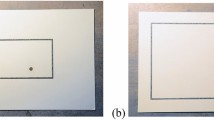Abstract
In this research, the impact of visual experience on the capacity to use egocentric (body-centered) and allocentric (object-centered) representations in combination with categorical (invariant non-metric) and coordinate (variable metric) spatial relations was examined. Participants memorized through haptic (congenitally blind, adventitiously blind, and blindfolded) and haptic + visual (sighted) exploration triads of 3D objects and then they were asked to judge: “which object was closest/farthest to you?” (egocentric-coordinate); “which object was on your left/right?” (egocentric-categorical); “which object was closest/farthest to a target object (e.g., cone)?” (allocentric-coordinate); “which object was on the left/right of the target object (e.g., cone)?” (allocentric-categorical). The results showed a slowdown in processing time when congenitally blind people provided allocentric-coordinate judgments and adventitiously blind people egocentric-categorical judgments. Moreover, in egocentric judgments, adventitiously blind participants were less accurate than sighted participants. However, the overall performance was quite good and this supports the idea that the differences observed are more quantitative than qualitative. The theoretical implications of these results are discussed.

Similar content being viewed by others
References
Carreiras M, Codina B (1992) Spatial cognition of the blind and sighted: visual and amodal hypotheses. Curr Psychol Cogn 12(1):51–78
Cattaneo Z, Vecchi T, Cornoldi C, Mammarella I, Bonino D, Ricciardi E, Pietrini P (2008) Imagery and spatial processes in blindness and visual impairment. Neurosci Biobehav Rev 32(8):1346–1360
Coluccia E, Mammarella I, Cornoldi C (2009) Centred egocentric, decentred egocentric, and allocentric spatial representations in the peripersonal space of congenital total blindness. Perception 38(5):679–693
Iachini T, Ruggiero G (2010) The role of visual experience in mental scanning of actual pathways: evidence from blind and sighted people. Perception 39:953–969
Iachini T, Ruggiero G, Conson M, Trojano L (2009) Lateralization of egocentric and allocentric spatial processing after parietal brain lesions. Brain Cogn 69(3):514–520
Kosslyn SM (1994) Image and brain: the resolution of the imagery debate. MIT Press, Massachusetts
Kosslyn SM, Thompson WL, Gitelman DR, Alpert NM (1998) Neural systems that encode categorical versus coordinate spatial relations: PET investigations. Psychobiology 26:333–347
Milner AD, Goodale MA (1995) The visual brain in action. Oxford University Press, Oxford
Postma A, Zuidhoek S, Noordzij ML, Kappers AML (2007) Differences between early-blind, late-blind, and blindfolded-sighted people in haptic spatial-configuration learning and resulting memory traces. Perception 36:1253–1265
Rieser JS, Hill EW, Talor CR, Bradfield A, Rosen S (1992) Visual experience, visual field size, and the development of nonvisual sensitivity to the spatial structure of outdoor neighbourhoods explored by walking. J Exp Psychol Gen 121(2):210–221
Ruggiero G, Ruotolo F, Iachini T (2009) The role of vision in egocentric and allocentric spatial frames of reference. Cogn Process 10(Suppl 2):S283–S285
Ruotolo F, Iachini T, Postma A, van der Ham IJM (2011a) Frames of reference and categorical and coordinate spatial relations: a hierarchical organization. Exp Brain Res 214(4):587–595
Ruotolo F, van der Ham IJM, Iachini T, Postma A (2011b) The relationship between allocentric and egocentric frames of reference and categorical and coordinate spatial relations. Q J Exp Psychol (Hove) 64(6):1138–1156
Ruotolo F, Ruggiero G, Vinciguerra M, Iachini T (2012) Sequential vs simultaneous encoding of spatial information: a comparison between the blind and the sighted. Acta Psychol 139(2):382–389
Conflict of interest
This supplement was not sponsored by outside commercial interests. It was funded entirely by ECONA, Via dei Marsi, 78, 00185 Roma, Italy.
Author information
Authors and Affiliations
Corresponding author
Rights and permissions
About this article
Cite this article
Ruggiero, G., Ruotolo, F. & Iachini, T. Egocentric/allocentric and coordinate/categorical haptic encoding in blind people. Cogn Process 13 (Suppl 1), 313–317 (2012). https://doi.org/10.1007/s10339-012-0504-6
Published:
Issue Date:
DOI: https://doi.org/10.1007/s10339-012-0504-6




